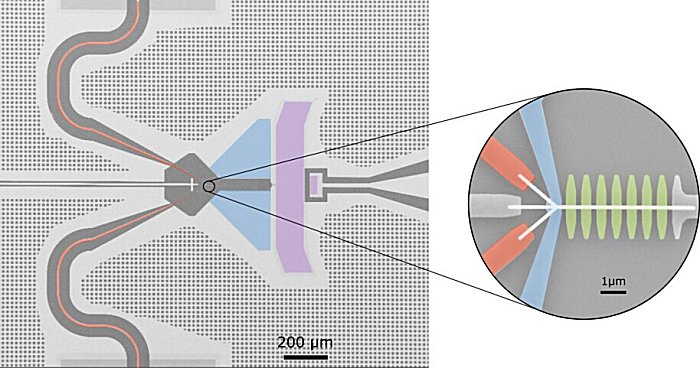Eddie Gonzales Jr. – MessageToEagle.com – Scientists in Finland have developed a nanodevice that can measure the absolute power of microwave radiation down to the femtowatt level at ultra-low temperatures — a scale trillion times lower than routinely used in verifiable power measurements.
Image of the power sensor on a silicon chip. Credit: Jean-Philippe Girard/Aalto University
The device has the potential to significantly advance microwave measurements in quantum technology.
Measuring extremely low power
Quantum science takes place mostly at ultra-low temperatures using devices called dilution refrigerators. The experiments also have to be done at tiny energy levels — down to the energy level of single photons or even less. Researchers have to measure these extremely low energy levels as accurately as possible, which means also accounting for heat — a persistent problem for quantum devices.
To measure heat in quantum experiments, scientists use a special type of thermometer called a bolometer. An exceptionally accurate bolometer was recently developed at Aalto by a team led by Mikko Möttönen, associate professor of quantum technology at Aalto and VTT, but the device had more uncertainty than they had hoped for. Although it enabled them to observe the relative power level, they couldn’t determine the absolute amount of energy very accurately.
In the new study, Möttönen’s team worked with researchers at the quantum-technology companies Bluefors and IQM, and VTT Technical Research Centre of Finland to improve the bolometer.
‘We added a heater to the bolometer, so we can apply a known heater current and measure the voltage. Since we know the precise amount of power we’re putting into the heater, we can calibrate the power of the input radiation against the heater power. The result is a self-calibrating bolometer working at low temperatures, which allows us to accurately measure absolute powers at cryogenic temperatures,’ Möttönen says.
According to Russell Lake, director of quantum applications at Bluefors, the new bolometer is a significant step forward in measuring microwave power.
‘Commercial power sensors typically measure power at the scale of one milliwatt. This bolometer does that accurately and reliably at one femtowatt or below. That’s a trillion times less power than used in typical power calibrations.’
Covering both deep and wide scales
Möttönen explains that the new bolometer could improve the performance of quantum computers. ‘For accurate results, the measurement lines used to control qubits should be at very low temperatures, void of any thermal photons and excess radiation. Now with this bolometer, we can actually measure that radiation temperature without interference from the qubit circuitry,’ he says.
The bolometer also covers a very broad range of frequencies.
‘The sensor is broadband, which means that it can measure what is the power absorbed in various frequencies. This is not a given in quantum technology as usually the sensors are limited to a very narrow band,’ says Jean-Philippe Girard, a scientist at Bluefors who also previously worked at Aalto on the device.
The team says the bolometer provides a major boost to quantum technology fields.
‘Measuring microwaves happens in wireless communications, radar technology, and many other fields. They have their ways of performing accurate measurements, but there was no way to do the same when measuring very weak microwave signals for quantum technology. The bolometer is an advanced diagnostic instrument that has been missing from the quantum technology toolbox until now,’ Lake says.
The work is a result of seamless collaboration between Aalto University and Bluefors, a perfect example of academy and industry complementing each other’s strengths. The device was developed at Aalto’s Quantum Computing and Devices (QCD) group, which is part of the Academy of Finland Centre of Excellence in Quantum Technology (QTF). They used Micronova cleanrooms that belong to the national research infrastructure OtaNano. Since the first experiments at Aalto, Bluefors has also successfully tested these devices in their own industrial facilities.
‘That shows that this is not just a lucky break in a university lab, but something that both the industrial and the academic professionals working in quantum technology can benefit from,’ Möttönen says.
Written by Eddie Gonzales Jr. – MessageToEagle.com Staff







